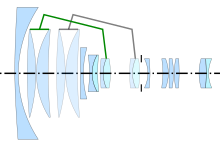| This article needs additional citations for verification. Please help improve this article by adding citations to reliable sources. Unsourced material may be challenged and removed. Find sources: "Zoomar lens" – news · newspapers · books · scholar · JSTOR (March 2020) (Learn how and when to remove this message) |

The Zoomar lens was the first commercially successful zoom lens, designed by optical engineer Frank G. Back as an outgrowth of his research on viewfinders and variable focal length projectors for the United States military.
History
Back developed an accessory "Vario-focus" viewfinder (designated PH-532/UF) for the Bell & Howell Eyemo camera variant PH-330-C issued by the United States Army Signal Corps during World War II; this incorporated many of the same principles as the commercial Zoomar lens, including the use of optical compensation.

Back applied for a patent in 1946 for a "Varifocal lens for cameras", which described the theory of its operation, using five sets of lenses: ordered from the object to the film, these were the front lens, variator, erector, compensator, and relay, with the variator and compensator mechanically fixed to each other and moving along the optical axis to vary the focal length; the other three sets of lenses remained stationary relative to the film plane. In the preferred embodiment, there were twenty-two lens elements in total: the front lens was a cemented group of two elements, the variator was an air-spaced group of four elements, the erector was an approximately symmetric set of eight elements in four cemented doublets, the compensator was a single cemented doublet, and the relay lens was an approximately symmetric air-spaced group of six elements.
A prototype version was used by WCBS-TV on July 21, 1947 to cover the Brooklyn Dodgers / Cincinnati Reds game. The first commercial version was used by Paramount newsreel photographers to cover the 1947 World Series.
In 1949, WAVE-TV became the first television station in the United States, to present a live telecast of the Kentucky Derby. The telecast was the first use of a Zoomar Lens in a television sports broadcast. The lens was loaned to WAVE by Back. Not long after the Derby, WAVE acquired a Zoomar lens of its own, which was frequently loaned to the other stations owned by WAVE-TV.

In 1968 Dr. Back bought the German optical firm Kilfitt from its owner Heinz Kilfitt, who retired. Kilfitt was one of the best and most innovative German lens makers of the 1950s and 1960s. The Münich factory started to produce the first production zoom lens in 1959 for 35mm still photography, the famous 36-82/2.8 Zoomar. It was originally made in Voigtländer Bessamatic and Exakta mount. Most Kilfitt and Zoomar lenses left the factory with versatile interchangeable lens mounts.
In 1986 Zoomar left the civilian market, concentrating on US military optics.
Frank Back
Frank Back was born in Vienna, Austria, in 1902; he earned bachelor's and doctoral degrees from the Technische Hochschule of Vienna and subsequently was employed by Georg Wolf, designing endoscopes. In July 1939, he emigrated to the United States. His varifocal lens design was an outgrowth of work he had previously performed for motion picture camera viewfinders and the projector part of a torpedo-targeting trainer.
Cultural influence
In 1957, Ernie Kovacs published his novel Zoomar, named after the lens and billed as "a sophisticated novel about love and TV". The novel chronicles a network executive's descent into madness.
References
- ^ Hall, Nick (April 2016). "Frank G. Back and the Postwar Television Zoom Lens". Technology and Culture. 57 (2): 353–379. doi:10.1353/tech.2016.0061. free access via National Library of Medicine
- "Camera PH-330-C Operating Instructions, Part Two, Section IV: Step-by-step operating procedure" (PDF). United States Army Signal Corps. Retrieved 1 May 2023.
Paragraph 58(g): Viewfinder PH-532/UF (Vario-focus). For full details concerning the installation, operation, and maintenance of this viewfinder, see TB Sig 159, Viewfinder PH-532/UF.
- ^ US Patent 2454686, Frank G. Back, "Varifocal lens for cameras", published November 23, 1948
- Kingslake, Rudolf (1989). "11: Varifocal and Zoom Lenses". A History of the Photographic Lens. San Diego, California: Academic Press. pp. 153–174. ISBN 0-12-408640-3.
- "Fairbanks Reports Favorable Response To First Zoomar Lens Demonstration" (PDF). Broadcasting / Telecasting. July 28, 1947. Retrieved September 12, 2017.
- "Betty Smith Looks at the South -- Garbo Considers". The New York Times. October 12, 1947. Retrieved September 12, 2017.
- "Zoom Lens for 35-mm. Camera Shoots Still Photos". Popular Science. Vol. 174, no. 5. Popular Science Publishing Co., Inc. May 1959. p. 187. Retrieved 13 March 2023.
- Deschin, Jacob (15 March 1959). "Zoom Lens For Stills". The New York Times. Retrieved September 12, 2017.
- "Kovacs in the Public Eye". Revolution of the Eye: Modern Art and the Birth of American Television. University of Maryland, Baltimore County: College of Arts, Humanities, and Social Sciences. Retrieved 1 May 2023.
External links
- [REDACTED] Media related to Zoomar Lens at Wikimedia Commons
- Zoom Lens History
This article about television technology is a stub. You can help Misplaced Pages by expanding it. |